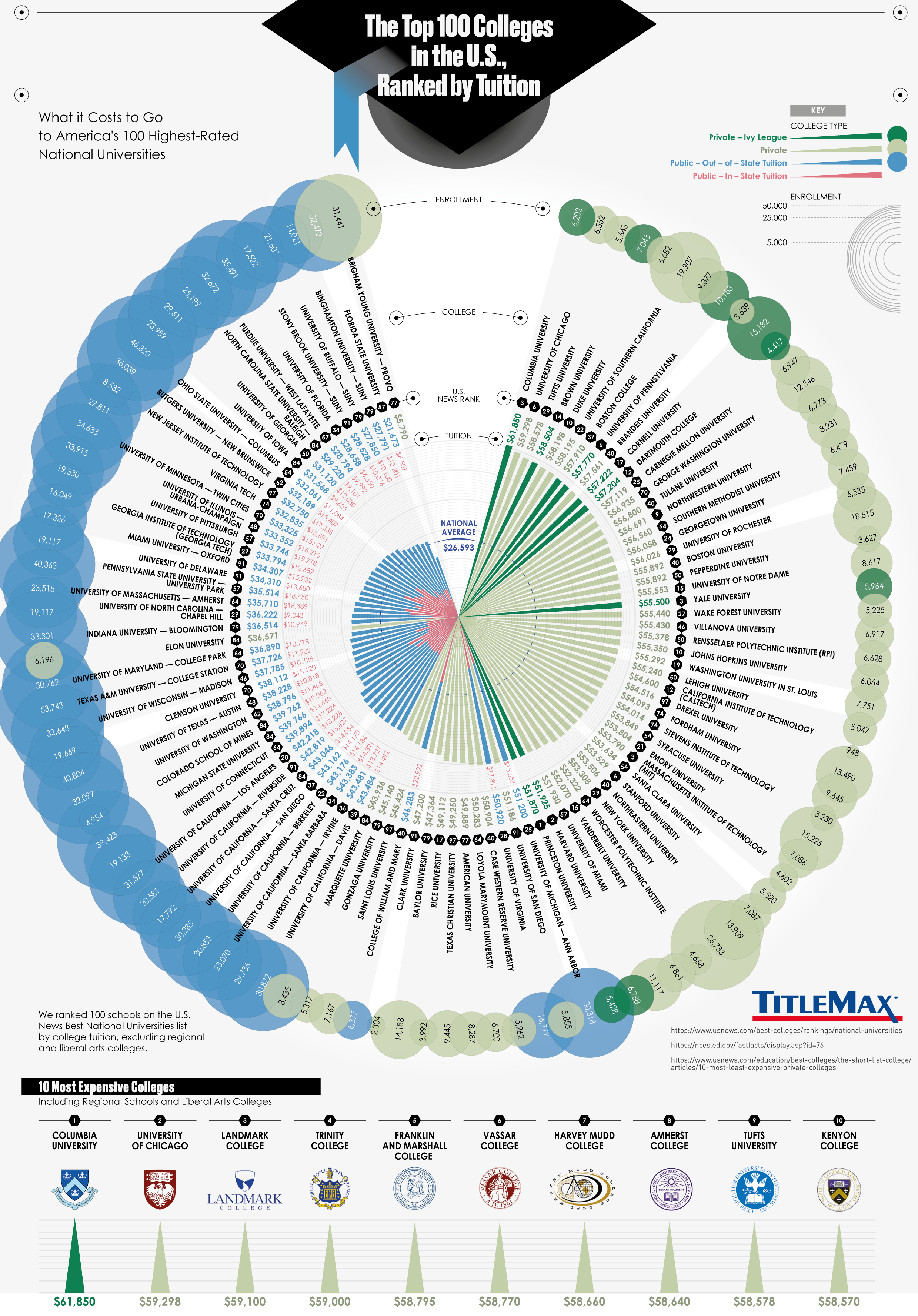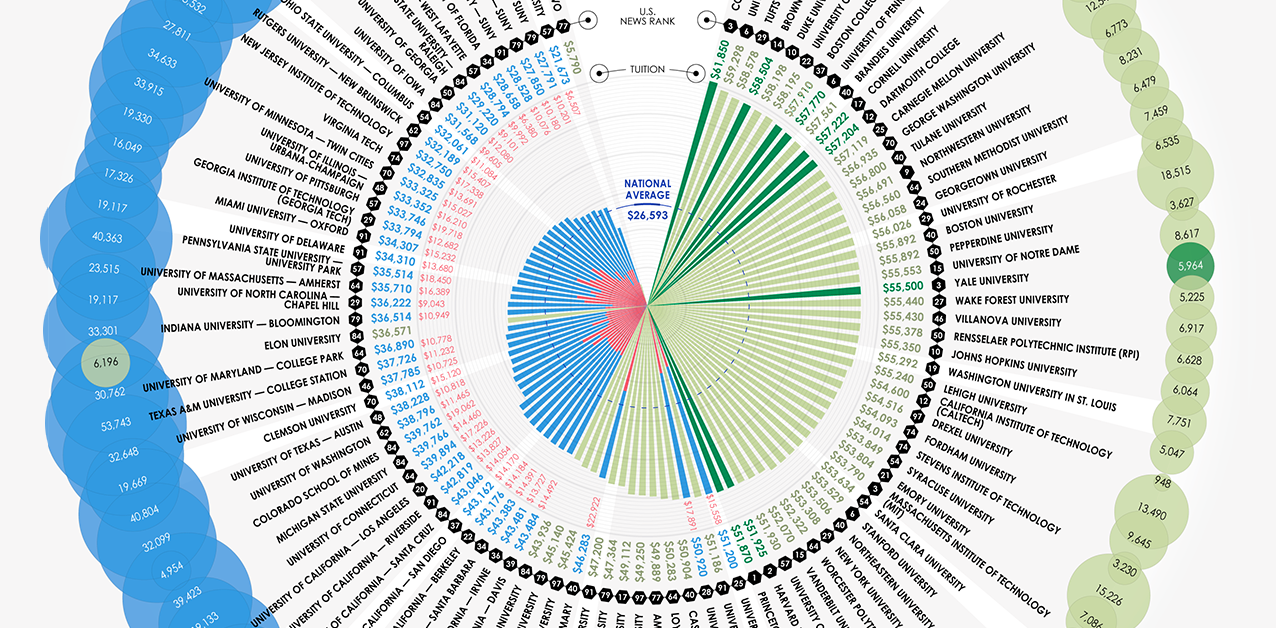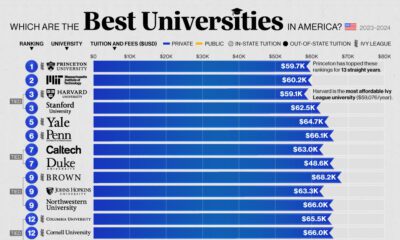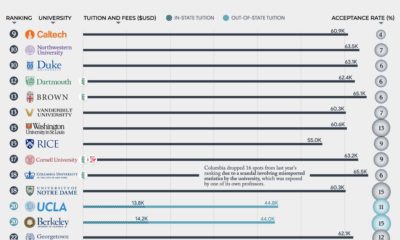Misc
The Top 100 U.S. Colleges, Ranked by Tuition
Click to view a larger version of this infographic
Top 100 U.S. Colleges, Ranked by Tuition
Attending a good school in the U.S. comes at a price.
Since 1985, college tuition has risen by roughly 500%, vastly outpacing almost all other increases in the cost of living. Today, there are more than 4,000 colleges in the country, ranging from high-flying Ivy League institutions to more modest, practical schools.
This infographic from TitleMax shows the top 100 colleges in America based on the U.S. News Best National Universities list, ranked by tuition from highest to lowest.
College Tuition: The Top 20 Most Expensive
From $5,000 to over $60,000, the price of college tuition for top U.S. schools is wide-ranging.
Columbia University, with a price tag of $61,850 takes top spot. Based in Manhattan, New York it has a rich history of graduates and instructors, including investing legends Benjamin Graham and Joel Greenblatt.
Although Columbia has the highest tuition cost, the school covers financial need with a mix of grants and work-study, which means low-income students don’t have to take on any student loan debt. This means a student coming from a home with $60,000 or less of income won’t be expected to pay anything toward tuition. That said, getting into the school is the tricky part. Columbia only admits 6% of applicants.
| Rank | Name | Ivy League? | Tuition |
|---|---|---|---|
| 1 | Columbia University | 🌿 | $61,850 |
| 2 | University of Chicago | $59,298 | |
| 3 | Tufts University | $58,578 | |
| 4 | Brown University | 🌿 | $58,504 |
| 5 | Duke University | $58,198 | |
| 6 | University of Southern California | $58,195 | |
| 7 | Boston College | $57,190 | |
| 8 | University of Pennsylvania | 🌿 | $57,770 |
| 9 | Brandeis University | $57,561 | |
| 10 | Cornell University | 🌿 | $57,222 |
| 11 | Dartmouth College | 🌿 | $57,204 |
| 12 | Carnegie Mellon University | $57,119 | |
| 13 | George Washington University | $56,935 | |
| 14 | Tulane University | $56,800 | |
| 15 | Northwestern University | $56,691 | |
| 16 | Southern Methodist University | $56,560 | |
| 17 | Georgetown University | $56,058 | |
| 18 | University of Rochester | $56,026 | |
| 19 | Boston University | $55,892 | |
| 20 | Pepperdine University | $55,892 |
Following Columbia is the University of Chicago. Its Booth School of Business was ranked the top MBA program in the world, with graduates averaging $135,000 in median income after graduation.
What may be surprising is that venerated institutions such as Harvard and Princeton don’t appear in the top 20, in terms of average tuition.
College Tuition: The Top 20 Least Expensive
How about the other end of the tuition spectrum for top schools in the country?
| Rank | Tuition | Name |
|---|---|---|
| 1 | $5,790 | Brigham Young University (Provo) |
| 2 | $21,673 | Florida State University |
| 3 | $27,791 | Binghamton University (SUNY) |
| 4 | $27,850 | University of Buffalo (SUNY) |
| 5 | $28,528 | Stony Brook University (SUNY) |
| 6 | $28,658 | University of Florida |
| 7 | $28,794 | Purdue University (West Laffayette) |
| 8 | $29,220 | North Carolina State University (Raleigh) |
| 9 | $31,120 | University of Georgia |
| 10 | $31,568 | University of Iowa |
| 11 | $32,061 | Ohio State University (Columbus) |
| 12 | $32,189 | Rutgers University (New Brunswick) |
| 13 | $32,750 | New Jersey Institute of Technology |
| 14 | $32,835 | Virginia Tech |
| 15 | $33,325 | University of Minnesota (Twin Cities) |
| 16 | $33,352 | University of Illinois (Urbana Champagne) |
| 17 | $33,746 | University of Pittsburgh |
| 18 | $33,794 | Georgia Institute of Technology (Georgia Tech) |
| 19 | $34,307 | Miami University (Oxford) |
| 20 | $34,310 | University of Delaware |
With a tuition of $5,790 Brigham Young University (Provo) has the lowest of the top 100, by far. Based in Provo, Utah it is owned by The Church of Jesus Christ of Latter-day Saints. The college restricts drinking coffee, alcoholic beverages, and other activities—requiring students to follow a strict honor code.
Also found on the list is the University of Florida and Purdue. Unsurprisingly, many public schools offer the most affordable college tuitions.
Misc
Visualizing the Most Common Pets in the U.S.
Lions, tigers, and bears, oh my!—these animals do not feature on this list of popular American household pets.

Visualizing The Most Common Pets in the U.S.
This was originally posted on our Voronoi app. Download the app for free on iOS or Android and discover incredible data-driven charts from a variety of trusted sources.
In this graphic, we visualized the most common American household pets, based on 2023-2024 data from the American Pet Products Association (accessed via Forbes Advisor).
Figures represent the number of households that own each pet type, rather than the actual number of each animal. The “small animal” category includes hamsters, gerbils, rabbits, guinea pigs, chinchillas, mice, rats, and ferrets.
What is the Most Popular American Household Pet?
Based on this data, dogs—one of the first domesticated animals—are the most common pets in the United States. In fact, around 65 million households own a dog, and spend an average of $900 a year on their care.
| Rank | Species | Households |
|---|---|---|
| 1 | 🐶 Dog | 65M |
| 2 | 🐱 Cat | 47M |
| 3 | 🐟 Freshwater Fish | 11M |
| 4 | 🐰 Small Animals | 7M |
| 5 | 🐦 Bird | 6M |
| 6 | 🦎 Reptile | 6M |
| 7 | 🐴 Horse | 2M |
| 8 | 🐠 Saltwater Fish | 2M |
Note: Households can own multiple pets, and are counted for all relevant categories.
Cats rank second, at 47 million households, and these smaller felines are a little less expensive to own at $700/year according to Forbes estimates.
But aside from these two juggernauts, there are plenty of other common pet types found in households across the country.
Freshwater fish can be found in 11 million households, along with small animals—rabbits, hamsters, guinea pigs—in 7 million. Meanwhile, nearly 6 million homes have birds or reptiles.
Pet Ownership is on the Rise in America
Forbes found that 66% of all American households (numbering 87 million) own at least one pet, up from 56% in 1988. One third of these (29 million) own multiple pets.
A combination of factors is driving this increase: rising incomes, delayed childbirth, and of course the impact of the pandemic which nearly cleared out animal shelters across the globe.
America’s loneliness epidemic may also be a factor. Fledgling research has shown that single-individual households with pets recorded lower rates of loneliness during the pandemic than those without a pet.
-

 Lithium7 days ago
Lithium7 days agoRanked: The Top 10 EV Battery Manufacturers in 2023
-

 Green2 weeks ago
Green2 weeks agoTop Countries By Forest Growth Since 2001
-

 United States2 weeks ago
United States2 weeks agoRanked: The Largest U.S. Corporations by Number of Employees
-

 Maps2 weeks ago
Maps2 weeks agoThe Largest Earthquakes in the New York Area (1970-2024)
-

 Green2 weeks ago
Green2 weeks agoRanked: The Countries With the Most Air Pollution in 2023
-

 Green2 weeks ago
Green2 weeks agoRanking the Top 15 Countries by Carbon Tax Revenue
-

 Markets2 weeks ago
Markets2 weeks agoU.S. Debt Interest Payments Reach $1 Trillion
-

 Mining2 weeks ago
Mining2 weeks agoGold vs. S&P 500: Which Has Grown More Over Five Years?








